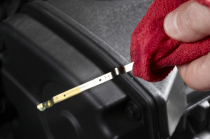
ncgenerators.com
Coolant Systems
Is your unit is at least 5 years old?
Typically a radiator flush including hose and belt replacements is performed every 5 years. If coolant system maintenance is not performed, the loss of integrity for external metals, internal water jackets components or any parts or fittings associated with the coolant system can be lost. The loss of this integrity will cause expensive repairs, failiure of the system when you need it, or worse case scenario, repair cost after the failure of a generator when you needed it. Freeze plugs, which are basically engine block mold caps, tend to fail first depending on the Ph level of the coolant. For some engines there can be several, different sizes, and in places making them extremely difficult to replace. Generator engines for standby generator sets do not operate routinely, except for the weekly 15 minute run, if this run period occurs. If the higher temperatures associated with engine run are not present on a regular basis, like with engines in your automobile, then condensation pellets are more likely to form inside the engine block, on the engine block, and also in any lubricants associated with the engine. The weekly run for some generators may not create enough heat in the block to evaporate these pellets!
Engine manufacturers recommend yearly coolant system flushes, however during our scheduled generator service trips we monitor the PH levels and condition of the coolant and both meet recommended specifications during this first 4 to 5 year period. Hose and belt manufacturers recommend hose and belt replacement every 4 to 5 years and I have included their technical reasons below.
The Enemy Within:
What you do not see, can hurt you! That's what Gates engineers discovered during four years of field testing on fleet vehicles. In these tests, they identified the primary cause of coolant hose failure as an electrochemical attack on the rubber tube compound in the hose.
The phenomenon is known as electrochemical degradation, or ECD. It occurs because the hose, liquid coolant (ethylene glycol antifreeze and water), and the engine/radiator fittings form a galvanic cell or "battery." This chemical reaction causes micro cracks in the hose tube, allowing the coolant to attack and weaken the hose reinforcement.
A replacement interval of four years for all coolant carrying hoses -- especially the upper radiator, bypass and heater hoses -- can help prevent unexpected failure from ECD. The incidence of hose failure increases sharply after four years.
Information concerning coolant systems
Learning Coolant Fundamentals.pdf
Adobe Acrobat document [136.9 KB]


